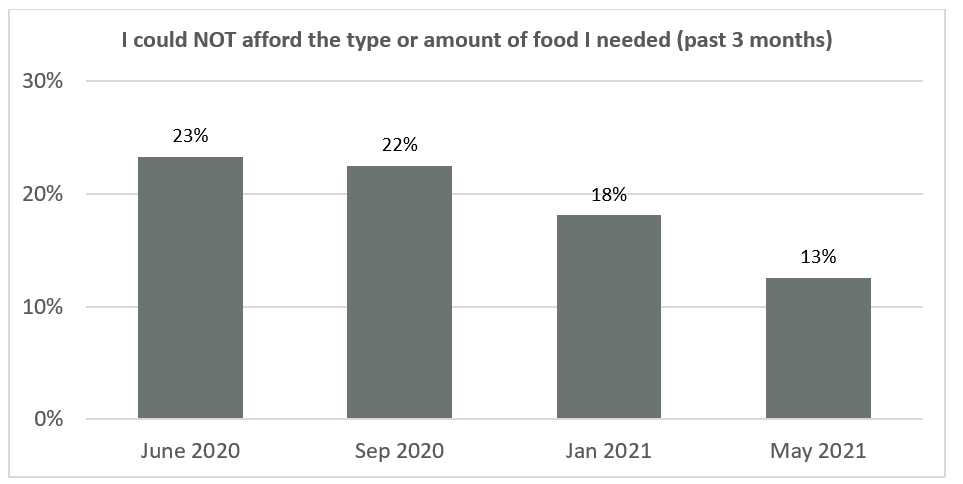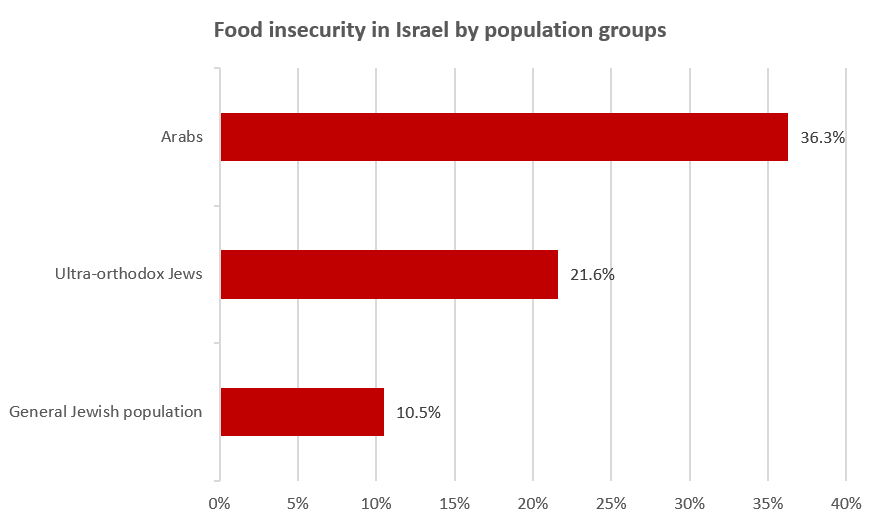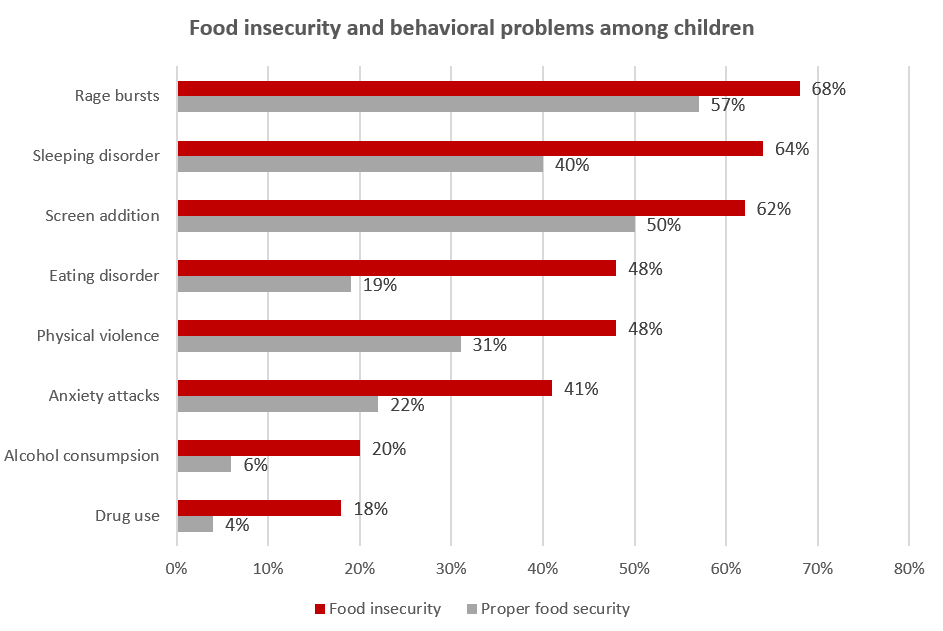By Oren Heller, Postdoctoral Research Associate; Mika R Moran, Data Analyst III; Yaniv Shlomo, Senior Fellow; Yung Chun, Data Analyst III; and Michal Grinstein-Weiss, Director.
Food insecurity, defined as insufficient access to safe and nutritious food, is yet another public health challenge exacerbated by the pandemic. Though the causes are multi-faceted and complex, recent data obtained by the Social Policy Institute at Washington University in St. Louis indicate a strong link between food insecurity and unemployment during the pandemic in Israel. Furthermore, we found unemployment rates had an alarming correlation to food insecurity among children—a concerning finding given the critical role of nutrition in shaping children’s physical, mental and cognitive development.
Trends in food insecurity throughout the COVID-19 economic crisis
Results from SPI’s four-wave survey suggest a link between the pandemic economic effects and food insecurity in Israel. According to the Israeli Central Bureau of Statistics, unemployment (including furlough) rate peaked at 34.6% in April 2020. In the meantime, according to the SPI data, food insecurity peaked at 23% in June 2020, two months after the unemployment peak. Since then, unemployment and food insecurity rates decreased and reached 6.8% and 13% in May 2021.

Food insecurity in Israel: Prevalence and distribution
Intrigued and motivated by these results from the four-wave survey in Israel, a separate SPI web-based survey was developed and executed to explore food insecurity among a representative sample of parents in Israel (n=1,054) on August 18-22, 2021. According to the results, as of August 2021, nearly one in five Israeli families (17%) suffers from food insecurity. Furthermore, food insecurity was disproportionately more prevalent among socioeconomically disadvantaged families. For instance, ethnic and religious minority groups were more likely to experience food insecurity than others―Arab Israelis and Ultra-orthodox Jews were 3.5 times and two times more likely to report food insecurity than the general Jewish population in Israel (36.2% and 21.6% vs 10.5%, p<0.001 respectively). Also, compared to both-parent households (of which 16% experienced food insecurity), single-parent households, especially single-mother households, were substantially more vulnerable to food insecurity (32% compared to 23% in single father households).

Food insecurity and pandemic-related employment changes
Our research demonstrates that sudden income loss is strongly correlated with food insecurity. Among those experiencing food insecurity, 30% received salary cuts and about a quarter (26%) were laid off, given unpaid leave (25%), or had their working hours reduced (27%). Overall, food insecurity was more common (25-30%) among those who experienced negative changes in their employment status due to the COVID-19 pandemic, as compared to those who did not experience any change (10%).

Food insecurity and children’s behavioral problems during the COVID-19 pandemic
Lastly, food insecurity seems to be linked to several behavioral problems of children, such as rage bursts, physical violence, screen addiction, anxiety attacks, sleeping and eating disorders and more. These findings point at the immediate effects of food insecurity on children’s mental well-being, on top of other long-term health effects.

Summary and policy recommendations
In Israel, as in other high-income countries, food insecurity is known to disproportionally affect vulnerable groups, and this was amplified during the COVID-19 pandemic. Our findings echoed these trends showing a high prevalence of food insecurity among economically disadvantaged groups, such as the Arab minority, ultra-orthodox Jews, and single-parent households during the pandemic. Our results further imply a direct link between food insecurity during the pandemic and pandemic-related socioeconomic crises. Food insecurity was more common among those experiencing worsening employment conditions. This also implies a ripple effect of insufficient social welfare policies during the pandemic, which further deteriorated the health situation of underserved population groups. Not only do these groups suffer from worsening working conditions, but their ability to obtain sufficient nutritious food is harmed and their children’s health is negatively impacted.
Our study supports a recent report by Israel’s National Insurance Institute Israel, which indicates that 17% of Israeli households suffer from food insecurity and that members of households living in food insecurity are also likely to experience adverse health conditions, such as chronic diseases, diabetes and anemia. However, there is still a need for more research on this phenomenon in order to understand its severity and to develop policies to address it. According to our survey, only 12% of food-insecure families receive support from welfare authorities, while 37% seek support from family and friends. These findings echo the perception that food insecurity is an anecdotal problem of a few extremely marginalized groups, while in fact, our research demonstrates that this is a widespread problem that requires stronger social welfare policies.
In the short term, families and individuals who experience economic struggles due to the pandemic should receive immediate financial support. In the long term, government funds should be allocated to support underserved populations and reduce poverty. This can be done both through designated budget assistance for food stamps, as has been done in the U.S. by increasing food allowances (SNAP) to an amount that was higher than before the pandemic. In addition, school lunch programs play an important role in ensuring proper food security for children. School lunch programs in elementary schools should be extended to cover as many, if not, all schools in the country. Furthermore, school lunch programs should be extended to include middle and high schools. This is especially essential given that, according to our findings, more than half of the food-insecure households in our sample included elementary school-aged children, and a third had middle- and high-school-aged children.